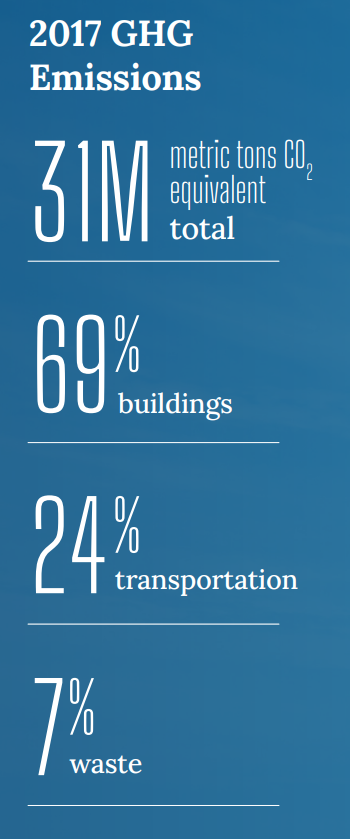Electrify Chicago
According to the
2022 Chicago Climate Action Plan,
a whopping 69% of Chicago's emissions come from buildings, making it
our biggest challenge and our biggest opportunity as a city to tackle
change. At Electrify Chicago we want to showcase some of the best and worst performing
buildings in the city using publicly available data and manual annotations to add
building photographs and label multi-building owners like universities.
You can start by looking at Chicago's buildings with the highest greenhouse gas intensity - this means that they use the most energy when adjusted per unit of square foot, so big buildings could actually perform much better than very inefficient small buildings on this metric.
Legislative update! 🎉
As of late January 2024, legislation is being introduced to require new buildings use more efficient forms of water and space heating, via the Clean And Affordable Buildings Ordinance (CABO), which will reduce the number of highly polluting and inefficient that end up on this site.
If you're in Chicago,
write to your alderman to support the CABO!
Chicago Buildings by Greenhouse Gas Intensity
Note: Data only includes large Chicago buildings from 2021, unless explicitly stated otherwise.
Note: This data only includes buildings whose emissions are reported
under the
Chicago Energy Benchmarking Ordinance. According to the City “As of 2016,
this list includes all commercial, institutional, and residential buildings larger than
50,000 square feet.” This dataset is also then filtered to only buildings with
reported emissions > 1,000 metric tons CO2 equivalent.
This data is also from 2021, but when new benchmark data is available, we'll update the site.
| Property Name / address | Primary Property Type |
Greenhouse Gas Intensity (kg CO2 eq./sqft) |
Total Greenhouse Emissions (metric tons CO2 eq.) |
|---|---|---|---|
|
850 Eastwood
850 W EASTWOOD AVE
| Multifamily Housing | 5.3 kg/sqft
Lowest 28%
| 1,303 tons
Highest 36%
|
|
1900 W. Farwell, LLC
1900 1910 W FARWELL AVE
| Multifamily Housing | 5.3 kg/sqft
Lowest 28%
| 311 tons
Lowest 10%
|
|
2071 N Southport Avenue
2071 N Southport Avenue
| Office | 5.2 kg/sqft
Lowest 27%
| 428 tons
Lowest 20%
|
|
Grand & Orleans
330 W Grand Ave
| Multifamily Housing | 5.2 kg/sqft
Lowest 27%
| 1,087 tons
Highest 42%
|
|
Balmoral Plaza Condominium
2606-2610 W Balmoral Ave
| Multifamily Housing | 5.2 kg/sqft
Lowest 27%
| 273 tons
Lowest 7%
|
|
Wicker Park Connection - 1640 W Division
1640 W Division St
| Multifamily Housing | 5.2 kg/sqft
Lowest 27%
| 765 tons
Lowest 45%
|
|
2019 - 4820 N Kedzie Ave
4820 N KEDZIE AVE
| Senior Living Community | 5.2 kg/sqft
Lowest 27%
| 312 tons
Lowest 10%
|
|
Mertz Hall - CFSU-ID# 254162
1125 W Loyola Ave
| Residence Hall/Dormitory | 5.2 kg/sqft
Lowest 27%
| 1,337 tons
Highest 35%
|
|
1515 Michigan Avenue Condominium Association
1515 S Michigan Ave
| Multifamily Housing | 5.2 kg/sqft
Lowest 27%
| 322 tons
Lowest 11%
|
|
The Lofts at 1800 Condominium Association
1800 W Grace St
| Multifamily Housing | 5.2 kg/sqft
Lowest 27%
| 951 tons
Highest 47%
|
|
550 W Fulton Condo Assoc.
550 W Fulton
| Multifamily Housing | 5.2 kg/sqft
Lowest 27%
| 334 tons
Lowest 12%
|
|
Surf II LLC
420 W Surf St
| Multifamily Housing | 5.2 kg/sqft
Lowest 27%
| 296 tons
Lowest 9%
|
|
Louis Pasteur Elementary School
(CPS)
5825 S Kostner Ave
| K-12 School | 5.2 kg/sqft
Lowest 27%
| 511 tons
Lowest 28%
|
|
Norman A Bridge Elementary School
(CPS)
3800 N New England Ave
| K-12 School | 5.2 kg/sqft
Lowest 27%
| 462 tons
Lowest 23%
|
|
Mark Sheridan Math & Science Academy
(CPS)
533 W 27th St
| K-12 School | 5.2 kg/sqft
Lowest 27%
| 405 tons
Lowest 18%
|
Data Source:
Chicago Energy Benchmarking Data
